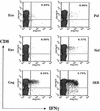Human immunodeficiency virus type 1 (HIV-1)-specific CD8+-T-cell responses for groups of HIV-1-infected individuals with different HLA-B*35 genotypes
- PMID: 12438586
- PMCID: PMC136673
- DOI: 10.1128/jvi.76.24.12603-12610.2002
Human immunodeficiency virus type 1 (HIV-1)-specific CD8+-T-cell responses for groups of HIV-1-infected individuals with different HLA-B*35 genotypes
Abstract
Human immunodeficiency virus type 1 (HIV-1)-infected individuals with HLA-B*35 allelic variants B*3502/3503/3504/5301 (B*35-Px) progress more rapidly to AIDS than do those with B*3501 (B*35-PY). The mechanisms responsible for this phenomenon are not clear. To examine whether cellular immune responses may differ according to HLA-B*35 genotype, we quantified HIV-1-specific CD8(+)-T-cell (CTL) responses using an intracellular cytokine-staining assay with specimens from 32 HIV-1-positive individuals who have B*35 alleles. Among them, 75% had CTL responses to Pol, 69% had CTL responses to Gag, 50% had CTL responses to Nef, and 41% had CTL responses to Env. The overall magnitude of CTL responses did not differ between patients bearing B*35-Px genotypes and those bearing B*35-PY genotypes. A higher percentage of Gag-specific CTL was associated with lower HIV-1 RNA levels (P = 0.009) in individuals with B*35-PY. A negative association between CTL activity for each of the four HIV antigens and viral load was observed among individuals with B*35-PY, and the association reached significance for Gag. No significant relationship between CTL activity and viral load was observed in the B*35-Px group. The relationship between total CTL activity and HIV RNA among B*35-Px carriers differed significantly from that among B*35-PY carriers (P < 0.05). The data are consistent with the hypothesis that higher levels of virus-specific CTL contribute to protection against HIV disease progression in infected individuals with B*35-PY, but not in those with B*35-Px.
Figures




Similar articles
-
Rapid progressing allele HLA-B35 Px restricted anti-HIV-1 CD8+ T cells recognize vestigial CTL epitopes.PLoS One. 2010 Apr 21;5(4):e10249. doi: 10.1371/journal.pone.0010249. PLoS One. 2010. PMID: 20422053 Free PMC article.
-
HIV-1-specific cytotoxic T lymphocyte (CTL) responses against immunodominant optimal epitopes slow the progression of AIDS in China.Curr HIV Res. 2008 Jun;6(4):335-50. doi: 10.2174/157016208785132473. Curr HIV Res. 2008. PMID: 18691032
-
Evidence of presentation of multiple HIV-1 cytotoxic T lymphocyte epitopes by HLA-B*3501 molecules that are associated with the accelerated progression of AIDS.J Immunol. 1997 May 15;158(10):5026-34. J Immunol. 1997. PMID: 9144523
-
HIV-specific cytotoxic T-cells in HIV-exposed but uninfected Gambian women.Nat Med. 1995 Jan;1(1):59-64. doi: 10.1038/nm0195-59. Nat Med. 1995. PMID: 7584954
-
Identification of highly conserved and broadly cross-reactive HIV type 1 cytotoxic T lymphocyte epitopes as candidate immunogens for inclusion in Mycobacterium bovis BCG-vectored HIV vaccines.AIDS Res Hum Retroviruses. 2000 Sep 20;16(14):1433-43. doi: 10.1089/08892220050140982. AIDS Res Hum Retroviruses. 2000. PMID: 11018863 Review.
Cited by
-
Major histocompatibility complex class I alleles associated with slow simian immunodeficiency virus disease progression bind epitopes recognized by dominant acute-phase cytotoxic-T-lymphocyte responses.J Virol. 2003 Aug;77(16):9029-40. doi: 10.1128/jvi.77.16.9029-9040.2003. J Virol. 2003. PMID: 12885919 Free PMC article.
-
Collaboration of a Detrimental HLA-B*35:01 Allele with HLA-A*24:02 in Coevolution of HIV-1 with T Cells Leading to Poorer Clinical Outcomes.J Virol. 2021 Nov 9;95(23):e0125921. doi: 10.1128/JVI.01259-21. Epub 2021 Sep 15. J Virol. 2021. PMID: 34523962 Free PMC article.
-
Post-Treatment Controllers: Role in HIV "Cure" Research.Curr HIV/AIDS Rep. 2016 Feb;13(1):1-9. doi: 10.1007/s11904-016-0296-x. Curr HIV/AIDS Rep. 2016. PMID: 26781112 Review.
-
Rapid progressing allele HLA-B35 Px restricted anti-HIV-1 CD8+ T cells recognize vestigial CTL epitopes.PLoS One. 2010 Apr 21;5(4):e10249. doi: 10.1371/journal.pone.0010249. PLoS One. 2010. PMID: 20422053 Free PMC article.
-
Fitness costs limit viral escape from cytotoxic T lymphocytes at a structurally constrained epitope.J Virol. 2004 Dec;78(24):13901-10. doi: 10.1128/JVI.78.24.13901-13910.2004. J Virol. 2004. PMID: 15564498 Free PMC article.
References
-
- Allen, T. M., D. H. O'Connor, P. Jing, J. L. Dzuris, B. R. Mothe, T. U. Vogel, E. Dunphy, M. E. Liebl, C. Emerson, N. Wilson, K. J. Kunstman, X. Wang, D. B. Allison, A. L. Hughes, R. C. Desrosiers, J. D. Altman, S. M. Wolinsky, A. Sette, and D. I. Watkins. 2000. Tat-specific cytotoxic T lymphocytes select for SIV escape variants during resolution of primary viraemia. Nature 407:386-390. - PubMed
-
- Appay, V., D. F. Nixon, S. M. Donahoe, G. M. Gillespie, T. Dong, A. King, G. S. Ogg, H. M. Spiegel, C. Conlon, C. A. Spina, D. V. Havlir, D. D. Richman, A. Waters, P. Easterbrook, A. J. McMichael, and S. L. Rowland-Jones. 2000. HIV-specific CD8+ T cells produce antiviral cytokines but are impaired in cytolytic function. J. Exp. Med. 192:63-75. - PMC - PubMed
-
- Betts, M. R., J. P. Casazza, B. A. Patterson, S. Waldrop, W. Trigona, T. M. Fu, F. Kern, L. J. Picker, and R. A. Koup. 2000. Putative immunodominant human immunodeficiency virus-specific CD8+ T-cell responses cannot be predicted by major histocompatibility complex class I haplotype. J. Virol. 74:9144-9151. - PMC - PubMed
-
- Betts, M. R., J. F. Krowka, T. B. Kepler, M. Davidian, C. Christopherson, S. Kwok, L. Louie, J. Eron, H. Sheppard, and J. A. Frelinger. 1999. Human immunodeficiency virus type 1-specific cytotoxic T lymphocyte activity is inversely correlated with HIV type 1 viral load in HIV type 1-infected long-term survivors. AIDS Res. Hum. Retrovir. 15:1219-1228. - PubMed
-
- Borrow, P., H. Lewicki, X. P. Wei, M. S. Horwitz, N. Peffer, H. Meyers, J. A. Nelson, J. E. Gairin, B. H. Hahn, M. B. A. Oldstone, and G. M. Shaw. 1997. Antiviral pressure exerted by HIV-1-specific cytotoxic T lymphocytes (CTLs) during primary infection demonstrated by rapid selection of CTL escape virus. Nat. Med. 3:205.. - PubMed
Publication types
MeSH terms
Substances
Grants and funding
LinkOut - more resources
Full Text Sources
Medical
Research Materials

